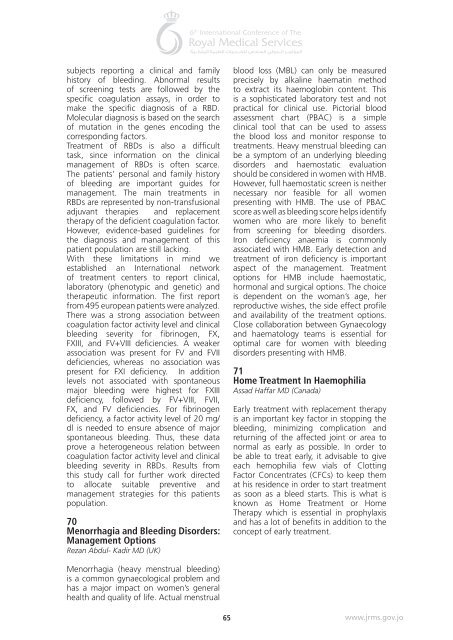Abstract book 6th RMS 16.indd
Abstract book 6th RMS 16.indd
Abstract book 6th RMS 16.indd
You also want an ePaper? Increase the reach of your titles
YUMPU automatically turns print PDFs into web optimized ePapers that Google loves.
subjects reporting a clinical and family<br />
history of bleeding. Abnormal results<br />
of screening tests are followed by the<br />
specific coagulation assays, in order to<br />
make the specific diagnosis of a RBD.<br />
Molecular diagnosis is based on the search<br />
of mutation in the genes encoding the<br />
corresponding factors.<br />
Treatment of RBDs is also a difficult<br />
task, since information on the clinical<br />
management of RBDs is often scarce.<br />
The patients’ personal and family history<br />
of bleeding are important guides for<br />
management. The main treatments in<br />
RBDs are represented by non-transfusional<br />
adjuvant therapies and replacement<br />
therapy of the deficient coagulation factor.<br />
However, evidence-based guidelines for<br />
the diagnosis and management of this<br />
patient population are still lacking.<br />
With these limitations in mind we<br />
established an International network<br />
of treatment centers to report clinical,<br />
laboratory (phenotypic and genetic) and<br />
therapeutic information. The first report<br />
from 495 european patients were analyzed.<br />
There was a strong association between<br />
coagulation factor activity level and clinical<br />
bleeding severity for fibrinogen, FX,<br />
FXIII, and FV+VIII deficiencies. A weaker<br />
association was present for FV and FVII<br />
deficiencies, whereas no association was<br />
present for FXI deficiency. In addition<br />
levels not associated with spontaneous<br />
major bleeding were highest for FXIII<br />
deficiency, followed by FV+VIII, FVII,<br />
FX, and FV deficiencies. For fibrinogen<br />
deficiency, a factor activity level of 20 mg/<br />
dl is needed to ensure absence of major<br />
spontaneous bleeding. Thus, these data<br />
prove a heterogeneous relation between<br />
coagulation factor activity level and clinical<br />
bleeding severity in RBDs. Results from<br />
this study call for further work directed<br />
to allocate suitable preventive and<br />
management strategies for this patients<br />
population.<br />
70<br />
Menorrhagia and Bleeding Disorders:<br />
Management Options<br />
Rezan Abdul- Kadir MD (UK)<br />
blood loss (MBL) can only be measured<br />
precisely by alkaline haematin method<br />
to extract its haemoglobin content. This<br />
is a sophisticated laboratory test and not<br />
practical for clinical use. Pictorial blood<br />
assessment chart (PBAC) is a simple<br />
clinical tool that can be used to assess<br />
the blood loss and monitor response to<br />
treatments. Heavy menstrual bleeding can<br />
be a symptom of an underlying bleeding<br />
disorders and haemostatic evaluation<br />
should be considered in women with HMB.<br />
However, full haemostatic screen is neither<br />
necessary nor feasible for all women<br />
presenting with HMB. The use of PBAC<br />
score as well as bleeding score helps identify<br />
women who are more likely to benefit<br />
from screening for bleeding disorders.<br />
Iron deficiency anaemia is commonly<br />
associated with HMB. Early detection and<br />
treatment of iron deficiency is important<br />
aspect of the management. Treatment<br />
options for HMB include haemostatic,<br />
hormonal and surgical options. The choice<br />
is dependent on the woman’s age, her<br />
reproductive wishes, the side effect profile<br />
and availability of the treatment options.<br />
Close collaboration between Gynaecology<br />
and haematology teams is essential for<br />
optimal care for women with bleeding<br />
disorders presenting with HMB.<br />
71<br />
Home Treatment In Haemophilia<br />
Assad Haffar MD (Canada)<br />
Early treatment with replacement therapy<br />
is an important key factor in stopping the<br />
bleeding, minimizing complication and<br />
returning of the affected joint or area to<br />
normal as early as possible. In order to<br />
be able to treat early, it advisable to give<br />
each hemophilia few vials of Clotting<br />
Factor Concentrates (CFCs) to keep them<br />
at his residence in order to start treatment<br />
as soon as a bleed starts. This is what is<br />
known as Home Treatment or Home<br />
Therapy which is essential in prophylaxis<br />
and has a lot of benefits in addition to the<br />
concept of early treatment.<br />
Menorrhagia (heavy menstrual bleeding)<br />
is a common gynaecological problem and<br />
has a major impact on women’s general<br />
health and quality of life. Actual menstrual<br />
65 www.jrms.gov.jo

















